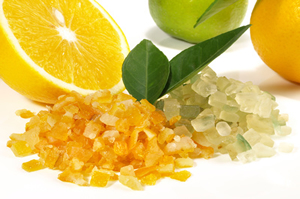Untitled Document

|
| |
Candied Fruits
|

Photo: © ExQuisine - Fotolia.com |
| |
|
Candied fruit is made by dipping or boiling pieces of fruit in a heavy syrup and then drying them. They are often rolled in granulated sugar after the drying process. The most common candied fruits used in German baking are Zitronat and Orangeat.
Zitronat
Zitronat is candied citron. It is made from the thick peel of the citron fruit. After partial de-salting and boiling to soften the peel, it is candied in a strong sucrose/glucose solution. The candied peel is sun-dried or put up in jars for future use. Zitronat is used in many baking recipes, especially the Christstollen.
Citron is a citrus fruit cultivated primarily for its aromatic and flavorful peel. It comes from the Citrus Medica tree, a thorny evergreen tree which prefers full sun and very warm weather. Citron fruits are yellow and extremely knobbly. The citron is native to India, and it is also widely cultivated around the Mediterranean, especially in Italy. It is believed that the citron was probably the first citrus fruit introduced to Europe.
An alternative to candied citron
If you don't like candied citron, an excellent alternative is candied lemon peel. Candied lemon peel tastes more natural and is less “sweet and gooey” than most candied citron.
Orangeat
Orangeat is candied orange peel. It is made from the peel of the Seville Orange (also known as "Bitter Orange"). The Seville Orange is an extremely tart orange grown throughout the Mediterranean region. Its rind is much thicker than other orange varieties.
Similar to Zitronat, Orangeat is orange peel which has been made by boiled and candied in a heavy syrup. After boiling, it is generally then taken from the syrup and placed in granulated sugar (sometimes powdered sugar) to toss and to coat.
|
|
|
|
|

